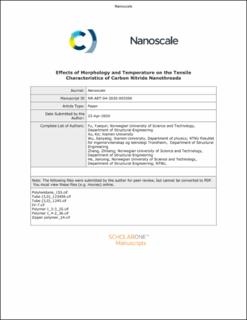Effects of Morphology and Temperature on the Tensile Characteristics of Carbon Nitride Nanothreads
Journal article, Peer reviewed
Accepted version

Åpne
Permanent lenke
https://hdl.handle.net/11250/2655254Utgivelsesdato
2020Metadata
Vis full innførselSamlinger
Originalversjon
10.1039/D0NR03206ASammendrag
Very recently synthesized carbon nitride nanothreads (CNNTs) by compressing crystalline pyridine show outperformance in chemical and physical properties over diamond nanothreads. Here, using first-principle based ReaxFF molecular dynamics (MD) simulations, a comprehensive investigation on mechanical characteristics of seven experimentally synthesized CNNTs is performed. All the CNNTs exhibit unique tensile properties that change with molecular morphology, atomic arrangement and the distribution of nitrogen in the skeleton. CNNTs with more effective loading covalent bonds at cross-sections are more mechanically robust. Surprisingly, tiny CNNT with periodic unit structures of 5462-cage shows extreme ductility because of formation of linear polymer via 4-step dissociation-and-reformation of bonds at extremely low temperature of 1 to 15 K, however, it yields by brittle failure at one cross-section with low ductility at higher temperature, similar to other CNNTs at different temperatures, which offers a feasible way to design a kind of lightweight material that can be used in ultra-low temperature conditions, for example, harsh deep space environment. Results also show that temperature significantly affects the fracture stress and rupture strain but not the effective stiffness. Analysis of atomic bond orders and bond lengthening reveals that the unique nonlinear elasticity of CNNTs is attributed to the occurrence of local bond transformations. This study provides physical insights into the tensile characteristics of CNNTs for design and application of the CNNT-based nanostructures as multifunctional materials.